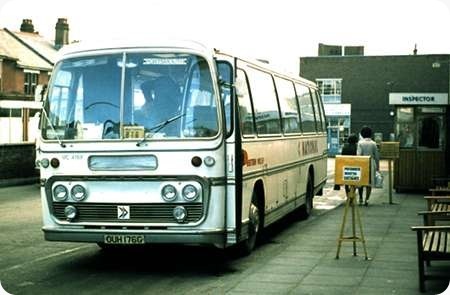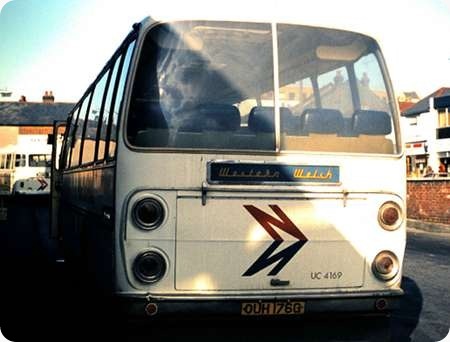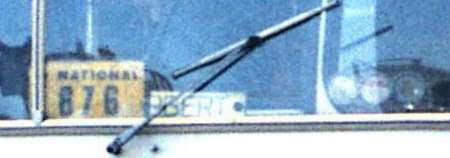Western Welsh – Leyland Leopard – OUH 176G – UC 4169
Western Welsh
1969
Leyland Leopard PSU3A/4RT
Plaxton C49F
Here are two views of OUH 176G, a PSU3A/4RT Leopard with Plaxton C49F bodywork new to Western Welsh in 1969. Seen at Southampton Coach Station in March 1976, she’s in NBC white, but there are some interesting features which may help redeem her!
While the destination blind is set at blank, there is what looks like a suction pad in the nearside windscreen telling us she’s going to Portsmouth. The sticker says this is the 876. She shows the "Red & White" style of fleet number, UC 4169. The rear end shows that she still has the gold on blue fleetname, with the double N logo on the luggage compartment door.
Photograph and Copy contributed by Pete Davies
22/12/13 – 08:50
I am a little bit "AEC" about Plaxtons – a sometimes critical fan and supporter. Post-war to 1982 they generally produced a quality product, well built and finished. Experience with an acquired Regal IV led Sheffield United Tours to approach Plaxtons to build the first Panorama because it was so well built (and survived quite a bad accident). Unfortunately, they also produced more than their share of dogs – the designs of which would have scared the children and curdled the milk. The Panorama Elite is, however, an acknowledged "Classic" – but even such classics were not perfect and Mk II and III versions went on to refine and improve on the original. National white probably did less damage to the straight lines of a Panorama Elite but it was introduced before the livery. We got used to seeing it in pre-corporate liveries – and they were far better for it. [Why has this one got two different colours on the rear seat backs?]
David Oldfield
22/12/13 – 09:43
David,
Thanks for your comments. If you mean the actual seat back below the headrests, I think it’s nothing more than shadow from the adjacent wall.
Pete Davies
22/12/13 – 10:21
Yes, I see that now, Pete.
David Oldfield
22/12/13 – 10:21
Offside is in bright sunshine and n/s is in shade, an equally silly question is, what is the gobbledegook in the rear fleetname display meant to be?
Tony Gallimore
22/12/13 – 11:21
Got it. Many thanks.
Tony Gallimore
22/12/13 – 15:49
I think the service number is more likely to be 676, which was a daily service from Treherbert to Portsmouth via Cardiff, Severn Bridge, Bristol, Bath, Salisbury and Southampton. Severn Bridge (Aust Services) was used as an interchange point by National Express at that period, with services from South Wales connecting with services to the south coast. The 876 was a weekend service between Liverpool and Paignton.
David Williamson
22/12/13 – 15:50
Gobbledegook it isn’t but misleading it can be especially as Western Welsh’s route map extended as far east as the English border in the 1970’s (and over it earlier days). Though I lived in the region for several years I never understood the boundaries of Red & White’s operating area and that of Western Welsh in Monmouthshire. At that time Western Welsh seemed to have more routes in East Monmouthshire than Red & White despite that being the ‘home’ area of the latter.
Orla Nutting
23/12/13 – 06:58
I take it, Orla, that your mention of the "English border and over it in earlier days" is because of the transfer of Monmouthshire from England to Wales around 1973. You are right about the arcane nature of R & W’s boundaries and Western Welsh wasn’t Eastern Welsh! Many years ago, I recall seeing a murky wartime photo of a Miller bus waiting in Gloucester Bus Station, blinded for Abergavenny. Maybe ‘anything went’ in those times and it was unusual, but maybe not. FYI, here is a list and historical data of companies which made up the Red & White group and nationalisation. One non-bus company stands out for me and that is Bulwark, whose lorries (often Albion – no surprise there) were seen all over in the south. Ironically, I think BET took them over in the end. LINK: //tinyurl.com/kw4ztlo
Chris Hebbron
23/12/13 – 06:58
Not that it makes things any easier to understand Orla, but I read recently that, like Western National, Western Welsh referred to the Great Western Railway rather than geography.
David Oldfield
23/12/13 – 08:38
You may well be right, David W, in saying it’s the 676, but I’ve always read it as 876. Strangely enough, I never saw a vehicle on this service which actually had a service number blind. Some of the Royal Blue fleet had started to have service numbers on their blinds by this time, where it might normally have said "ASSOCIATED MOTORWAYS".
Pete Davies
23/12/13 – 10:45
I think this has been posted elsewhere on this site. In 1929, the Great Western Railway’s bus services in South Wales were merged with those of a company called South Wales Commercial Motors. A new company, Western Welsh Omnibus Co. Ltd, was formed with a GWR share-holding.
This was during the period of large-scale acquisition of bus interests by the railways.
Geoff Kerr
23/12/13 – 11:55
My reference to the English Border in earlier days was because I believe that some WW service routes extended as far as Hereford and Gloucester (albeit they may have been joint services). When I lived in the region in the ’70’s they went only as far east as Chepstow (route 63, Blackwood to Chepstow via Usk) and as far north as Abergavenny (route 141 Abergavenny to Newport via Cwmbran). The successors to WW and R&W (National Welsh but branded R&W) did run services from Newport to Hereford and to Gloucester before that company folded and then Stagecoach took over the routes.
In the ’70’s R&W ran the service from Newport to Monmouth via Usk (service 60) which was east of the Newport-Abergavenny route and R&W ran the Newport-Blaenavon/Brynmawr via Pontypool routes which were west of the Abergavenny-Newport route but which had been part of WW services in the 1930’s.
Monmouthshire formally became part of Wales in 1974 under the local government reorganisation that created Gwent county. Before that there had been a long campaign by, primarily West Mon based, campaigners to have the county included in Wales whilst many in East Mon thought of the county as forming part of England. The present administrative district of Monmouthshire comprises largely the former east Monmouthshire.
It is correct that the ‘Western’ in the title arises from Great Western Railways’ holding in the company
Orla Nutting
23/12/13 – 14:20
To bring things up to date, Stagecoach South Wales which took over from Red & White, currently serves The Forest of Dean, Caldicot and services as far as Gloucester and Hereford.
Jim Hepburn
24/12/13 – 06:41
In fact, Jim, the Ross-on-Wye-based routes were transferred from Stagecoach South Wales to Stagecoach West in 2000 and are now branded ‘Stagecoach in Wye and Dean’. The 73, which originally went from Gloucester to Cardiff, was cut back to Newport, Chepstow, now only to Lydney. Hereford and Monmouth are still served.
Chris Hebbron
25/12/13 – 06:33
Ah Chris, you are forgetting the final twist in the tail of the 73. It was later extended from Lydney up through the Forest of Dean to Coleford and renumbered 23, in which form it operates today.
I do miss having a direct bus service from Gloucester to Chepstow and Newport – clearly few others did!
Rob McCaffery
25/12/13 – 11:38
Ooh, Rob, I didn’t know that! No wonder I haven’t seen a 73 around Gloucester for a while, now I come to think about it!
Chris Hebbron
27/12/13 – 17:55
Stagecoach now runs a 74/X74 Newport – Chepstow via Langstone (74 only) and Caldicot.
Newport Transport runs a 73 Newport – Chepstow via Langstone and Caerwent.
There is a separate (and infrequent) service between Lydney and Chepstow (James Bevan service 755).
Geoff Kerr
01/01/14 – 17:25
Prior to the formation of ‘National Express’, there was a daily Associated Motorways service between South Wales and Portsmouth. Some seasons the South Wales portion started from Aberdare, and others from Treherbert, but it was worked by Red & White’s Aberdare depot in both cases. The vehicle worked south one day and returned the next. When Nat Ex introduced route numbers, it acquired the number 772, but this changed to 676 after just a couple of seasons.
Once Nat Ex had become established, and the white livery prevailed, an additional, Saturdays only (at least, initially), ‘flyer’ from Treherbert to Portsmouth was added, which served only the major points, and completed the return trip within the one day. My understanding is that this journey was worked by Western Welsh’s Rhondda depot in Porth, and this can probably be confirmed since UC469 (the number carried by this vehicle prior to October ’75) was allocated to Porth in August ’75. Certainly, I only ever saw WW (or ex-Rhondda) vehicles on this working while I lived in Southampton (up to August 1975).
As far as the bus services were concerned, Red & White and WW were not true ‘area agreement’ companies, and significant parts of South East Wales were shared by the two operators. There were, however, a number of co-ordination schemes, most notably in the Monmouthshire valleys, which rationalised the operations when introduced in the mid-1960s. In that case, both companies held licenses for all of the services in the designated area, even though some were only operated by one of the companies. However many of the longer services – e.g. Newport-Brynmawr via several routes or Newport-Tredegar/Merthyr – were operated jointly. There was thus no ‘boundary’ between R&W and WW. In even earlier times it was even more complicated, as R&W had a share of the Cardiff-Barry service, while WW also worked on the Newport-Monmouth service. WW also worked to Hereford (from Brecon – service 739) as well, so they did indeed reach England.
Nigel Frampton
01/01/14 – 18:08
The ‘connexion’ between the Cardiff area and Portsmouth also extended to British Rail, who operated a regular service between the two cities, which still runs. My widowed mother used to take in her proportion of the many Welsh Summer holidaymakers, as ‘B&B guests’. I recall when the rail service was Class 33 hauled, these Southern diesel-electric locos working up to Shrewsbury at times, well outside their normal stomping ground! But I digress!
Chris Hebbron
Quick links to the - Comments Page - Contact Page - Home Page
Please leave a comment
Please Note if you want to send a photograph with your comment please use the Contact Page by clicking here or send as an attachment via email.





